#my money is on 'lost in the woods' its so campy
Note
Do you think Wei wuxian listens to weezer?

I don't know...I don't know...I really don't know.....
#poorly drawn mdzs#mdzs#wei wuxian#lan sizhui#blood#I mean this in the most sincerest way possible: This ask has become my 'does bruno mars is gay' to me and anyone in close enough proximity#I first read this after having just woken up and it rattled me so intensely#would he???? I don't know??? It's dad music but it also sort of works for someone a little bit out of step with time?#I'm a bit of a wwx kinnie and I love music but I don't really have any headcanons for what modern music he'd like#other than 'unironically classical music and its one of the first things he bonds with lwj over as teens'#(they get into very heated arguments about composers and arrangements)#but also. the concept of wwx really liking wheezer to the point its the first thing he's gotta check in on after 13 years dead?#*that* did me in real good#I hope people enjoy this one as much as I did#'Does wwx listen to wheezer' Please oh god wheezer and mdzs fans please come together to tell me what songs wwx would like#my money is on 'lost in the woods' its so campy#EDIT: just been informed weezer doesnt have an H in it..this is how much i know. thank u everyone who left weezer recs in comments and tags
466 notes
·
View notes
Text
Paganini Horror (1989)

Directed by Luigi Cozzi
Screenplay by Luigi Cozzi and Daria Nicolodi
Music by Vince Tempera
Country: Italy
Running time: 82 minutes
CAST
Daria Nicolodi as Sylvia Hackett
Jasmine Maimone as Kate
Pascal Persiano as Daniel
Maria Cristina Mastrangeli as Lavinia
Michel Klippstein as Elena
Pietro Genuardi as Mark Singer
Luana Ravegnini as Rita
Giada Cozzi as Sylvia (child)
Elena Pompei as Sylvia's mother
Donald Pleasence as Mr. Pickett

Paganini Horror is a terrible 1989 Italian horror movie set in a decrepit Venetian villa where a terrible (mostly) girl pop group film a terrible video for a terrible song based on the terrible idea of using cursed music by Paganini. The aural nonsense these tinsel wits conjure summons the cranky spirit of the deceased composer to dispatch them one by one in imaginative, but seriously underfunded ways. And probably to stop them screaming, because, hoo boy, do these ladies scream. If you are a massive fan of women screaming Paganini Horror is the movie for you, my unusual friend. Much of the running time of Paganini Horror involves neither Paganini nor horror but rather women running around what seems like one corridor and three rooms screaming. Occasionally they all meet up and scream at each other in the same room, or that one bloody corridor. I swear at some points they bounce up and down and flap their hands while screaming like overwrought teenagers at a pop concert.
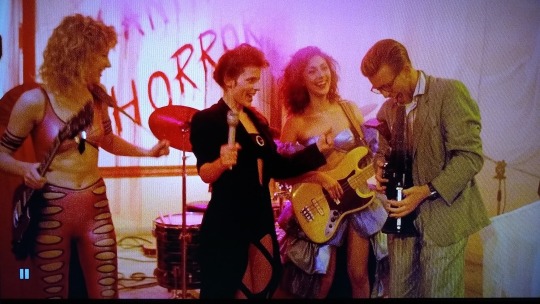
Which is ironic since they are a pop group themselves. They are the kind of fantastically talented (mostly) girl band who do the female cause no favours at all; the kind who play their guitars by keeping their fingers immobile and flat on the strings while provocatively moving their hips about while pulling faces which suggest they are experiencing a sexy form of menstrual cramp. The singer, Kate (Jasmine Maimone), doesn’t have an instrument because she is too busy prancing about, trying to see which she can open wider, her eyes or her mouth. The token bloke, Daniel (Pascal Persiano), is stuck behind the drums because no one wants to see his exposed belly button. I think they sing Bon Jovi’s terrible “You Give Love a Bad Name” but it’s kind of hard to tell. Anyway, they are so bad the movie doesn’t give the band a name (I think; I don’t really care), so we’ll call them The Chilblains. Whatever song The Chilblains are excreting, it isn’t good enough for their producer Lavinia (Maria Cristina Mastrangeli) whose ears apparently work, so Kate and Lavinia shout at each other, and things get so heated that Kate almost pushes a stool over but Lavinia arrests its fall just in time. Rock and roll Babylon! The Chilblains need new material to get them another million seller, and fast!
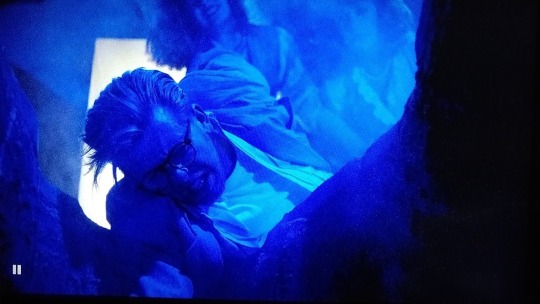
Daniel, the male drummer, sources some groovy material which will get the band back on track by, apropos of nothing, meeting a twitchy Donald Pleasence in a disused warehouse and purchasing a lost Paganini composition. Apparently, actually writing some decent music fails to occur to Daniel. The girls go wild for the fab synthed up sounds of groovy Paganini, and Lavinia books them into a spooky old house Paganini once passed water in, now owned by Daria Nicolodi’s Sylvia Hackett. The idea is to get top horror director Mark Singer (Pietro Genuardi) to make a smashing pop vid and get The Chilblains back shifting millions again. Unfortunately the video is shit. Even more unfortunately the restless spirit of Paganini is so upset by his music being co-opted by talentless chancers that it starts knocking them off in unintentionally amusing ways. You haven’t lived until you’ve seen a woman burned alive in a poorly constructed giant violin case, baby.

Niccolò Paganini (b.1782) was a real person who probably didn’t live to see a woman burned alive in a poorly constructed giant violin case, but he was a legendarily amazeballs Genoan violinist. While Paganini Horror is hardly a fit cinematic tribute, he is a good choice for a spooky killer. Much like Cher, he is purported to have consorted with the devil, selling his soul in return for prodigious talent. Back then, see, there were no video games or movies for unimaginative reactionaries to blame everything on, so in desperation bits of wood that could make sounds such as the violin were considered the “devil’s instrument”, indicative of poor moral character and likely to cause an excess of excitement. And so extravagant was Paganini’s talent that it was thought only a satanic source could explain it. Or, y’know, he was talented and practiced a lot. Your call. Paganini died in 1840, possibly from mercury poisoning from being treated for syphilis. Maybe from tuberculosis. I don’t know, what am I, a historian? Paganini’s spookiness survived after his death to the extent that he wasn’t laid to rest until 1876, when priests finished debating what they should do with him. Priests apparently had a lot of time on their hands back then. None of that matters since all Paganini Horror is bothered about is Paganini was very musical and a little bit eerie.

Unfortunately looking up Niccolò Paganini on The Internet turns out to be a lot more exciting than watching Paganini Horror. Particularly finding out that all his teeth fell out from his syphilis treatment. But if you are inclined towards terrible Italian horror movies Paganini Horror has the odd slender wisp of a delight. There’s the ever twinkly Donald Pleasence, being all sinister and stuff; and you get quite a bit more of him than I was expecting, which is nice. Unsatisfactory Italian horror movies form a magical late stage in Pleasence’s career, where he basically rocks up acting in a movie which exists only in his head, and ends up being the most interesting thing in the movie outside of his head. Although genre legend (and co-scripter) Daria Nicolodi is intermittently to be seen acting, mostly she just goes with the whole screaming thing. Michel Klippstein as Elena is the best thing in the movie, but not for her acting. Unfortunately it’s because for the bulk of the movie she wears a nasty green lycra jump suit studded with a nonsensical pattern of holes. It’s kind of fascinating in a wholly abysmal way. Paganini Horror isn’t always terribly interesting so you may often find your mind wandering, wondering just how sweaty Michel Klippstein’s get-up got. I bet they had to burn that outfit once the filming stopped. Ew! In the interests of decorum I shall draw a discreet veil of “mostly adequate” over the other performances.
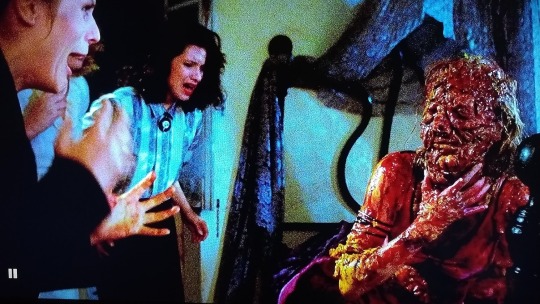
About on a par with the less than impressive acting is Luigi Cozzi’s relentlessly apathetic direction which exacerbates rather than disguises the clearly near lethal budgetary constraints. But would any more money have helped a horror movie helmed by someone so determined to so cluelessley fart away every death scene? Probably not. Make no mistake, Paganini Horror is not only terrible but, worse, it is often quite boring. This is quite a feat since the killer wears a gold mask and looks like a low budget musketeer prancing about and, as comically awesome as it is regrettably underutilised, there is also a gold violin with a spring loaded blade in the base. It’s like Cozzi has accepted a bet to make everything as tedious as humanly possible. In theory Paganini Horror has some clever ideas and creative slaughter, in practice however it is a drearily slow crawl punctuated by tedious screaming and hilariously cheap-shit SFX shenanigans. The best (i.e. worst) example is “The Invisible Barrier” which elicits some fantastic (i.e. rubbish) mime action as our cast pretend to be pushing against something that isn’t there, it also has a car crash into it but…off-screen! and a character is crushed to death by it, which just means the crew press a sheet of glass onto her face to distort it. Eyerolling never had it so good.
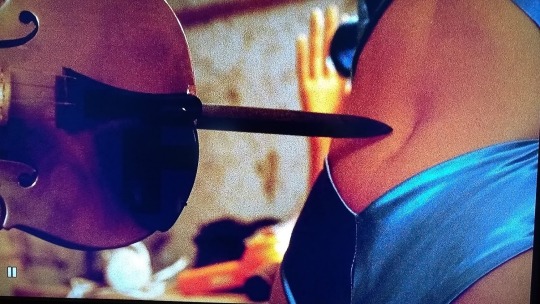
Be warned, sensation seekers of all ages, sure, Paganini Horror all sounds very camp and cheesetastic, but it is neither campy nor cheesy enough. It takes some weird anti-talent to render dull a movie which has a record producer who can identify a fungus by sight as being one used in the 18th century to give Stradivarius violins their unique sound. (I believe Kanye West has the same ability.) Don’t be fooled if any of that sounds fun; Paganini Horror is fun, but not fun enough by far. This Italian mis-fire is fit only for masochistic die-hards like myself rather than your average horror punter up for a good time. Ultimately then, not so much a case of Paganini Horror, but rather Paganini Torpor.

3 notes
·
View notes
Text
Ranking : John Carpenter (1948 - present)

If one were to name off ten American directors from the past half-century or so in rapid fire fashion, I’d be willing to put money on the table that a vast majority would have the name John Carpenter on that list. His impact on horror, suspense and psychological thriller films is undeniable, and his prolific ability to score his films with iconic music he creates puts him in the realm of legends. For a director that dwells in the areas usually set aside for disposable box office fodder, it is surprising that at least five of his films (and possibly more, depending on who’s doing the debating) could be consider bonafide classics.
Perhaps the most interesting thing about putting this list together was the discovery and true understanding of just how much range that Carpenter is capable of, even if his films are distinctly his both in terms of genre-based elements and directorial style. When it comes to the films Memoirs of an Invisible Man (a personal favorite from my pre-teen years) and Starman, I didn’t even realize they were John Carpenter films because they were so different from what I’d come to know him for. Revisiting the films I was familiar with gave me great joy, and taking in the films I’d overlooked or passed on gave me a deeper understanding of John Carpenter not only as a creative spirit, but as a man trying to stake a claim to his voice in an industry famous for conformity.
With that being said, I took all eighteen of John Carpenter’s feature length films and ranked them in terms of my personal enjoyment and opinion. As always, the floor is open for discussion, so feel free to share your thoughts and open up a dialogue, and enjoy!


18. The Ward (2010)
I’m going to be 100% honest with you all… coming in to this list, I pretty much had already decided that Ghosts of Mars was going to anchor this list. Fifteen movies in, it felt like my prediction would come to be. But then, something funny happened… The Ward showed up in my mailbox courtesy of Netflix DVD. I watched the film, and so many other films came to mind : Girl, Interrupted… One Flew Over the Cuckoo’s Nest… Shutter Island… Session 9… Unsane… The Jacket… the list goes on and on. That’s the thing about this film… nearly 40 years in, the last thing you’d expect John Carpenter to be is derivative. The Ward really wants to be an asylum thriller, a revenge-based ghost story and a period piece, but it never really commits to any of its aspirations, and what we’re left with is 90 minutes of Amber Heard, and in an information age obsessed with cancel culture, what’s going on in her personal life is infinitely more compelling than what she’s going through in The Ward. There are some good shots of fire in the film, and Mamie Gummer is acting circles around everyone she shares the frame with, but otherwise there’s not much to this one. Hopefully this won’t be the last film of Carpenter’s career.


17. Ghosts of Mars (2001)
If nothing else, Ghosts of Mars is an ambitious film. What it lacks in coherency, it makes up for in its amalgamation of ideas. The film is all at once a prisoner transport film, a film about a team of crack operatives, a film featuring a revolt and a tale about respecting the land that you intend to exploit for its resources. It sets itself up to be a John Carpenter take on Rashomon, with a number of stories being told through a singular unreliable narrator (due to the lack of those left to tell their own story). While there are some good ideas present in this film, not to mention some wonderful examples of non-traditional casting for an action movie, Ghosts of Mars falls short in its need to be everything to everyone. The film has garnered a cult following since its release, but as someone who saw this in theaters during its initial run, it still doesn’t do it for me.


16. Vampires (1998)
If From Dusk till Dawn isn’t enough to satisfy your Vampire Western cravings, then I humbly submit to you John Carpenter’s swing at the mixture in the form of Vampires. All the earmarks of both genres are present : a crack team of experts hit hard and early, an undercurrent of religion that neither praises nor damns it, a seemingly insurmountable antagonist with a single-minded blind focus, and even a damsel in distress forced to rough it with the roughnecks. Like many of his films, the Carpenter score plays unofficial star against the bananas series of events laid out. Speaking of crazy events, leave it to the likes of James Woods and Daniel Baldwin to take what could be best classified as pulp material and elevate it into the realms of honest entertainment. While not as flashy or fantastic as some of his previous films, the special effects work is effective (no pun intended), with a nice batch of memorable kills sprinkled throughout the film. If this film would’ve been made in the 1980s, I would argue that it could’ve been timeless, but unfortunately, it screams of the 1990s in all the ways that make a film dated, which is even funnier when you consider it was released near the end of the decade. Vampires is fun, but I’d be lying if I called it a classic.

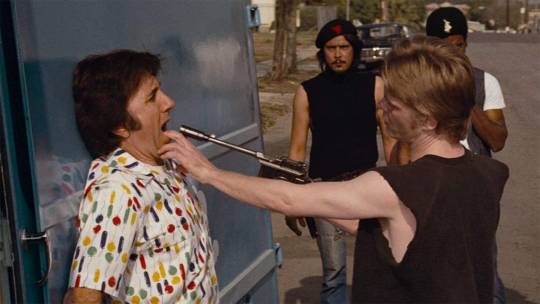
15. Assault on Precinct 13 (1976)
Assault on Precinct 13 marks the proper feature debut for John Carpenter, with Dark Star essentially being a glorified student film. Interestingly enough, the film has a ton of representation across the board in its casting, making it one of the more diverse films released on a major level with its Black lead and strong supporting cast featuring women, Black and Hispanic actors/actresses. At the time the film was released, the gang problem was going from an underground and isolated situation to more of a widespread panic, and Assault on Precinct 13 provides plenty of subtext in terms of how gangs are viewed, the perception of their impact on the community and, most importantly, their everlasting struggles with the police. Speaking of the police, there are some subtle jabs at the inept practices of police in terms of administration and the way the handle prisoners, all of which lead to a perfect storm of despair for our protagonists.


14. Escape from L.A. (1996)
This film marked the final collaboration between Kurt Russell and John Carpenter, and what an odd one to finalize such a rich and fruitful collaborative relationship. There are some things about the film that definitely work… Snake Pliskin is (and always will be) magic on the screen. Los Angeles certainly had the landmarks and the culture suitable for stylizing into a post-apocalyptic labyrinth of dangers. The statements the film makes on the moral majority and the isolation of people over cultural and ideological differences works as a harbinger for what could be in an extreme example, and has only become more relevant as time has passed. That being said, this film seems to not know whether it wants to be a comedy on the sly, or whether it’s just accepting of taking the often occasional odd detour for seemingly aesthetic purposes, which makes sense when one realizes that the film spent a decade in development hell simply because Carpenter was afraid to pull the trigger on a script he felt was “too light, too campy”. While a departure in comparison to Escape from New York, and definitely a tonal shift from the vast majority of the Carpenter films, it does have its moments… unfortunately, the moments are not frequent enough to put this one in the upper echelon of Carpenter’s work.

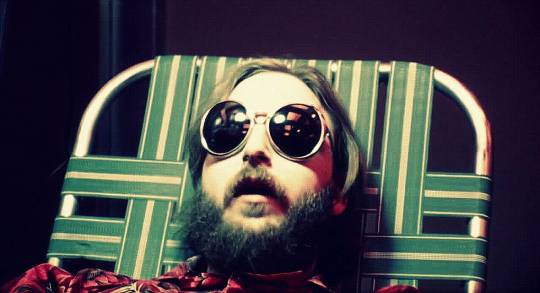
13. Dark Star (1974)
For a debut film, Dark Star already had enough elements to be distinctly John Carpenter… the use of an ensemble cast, DIY special effects, a John Carpenter score, and hilariously, a Kurt Russell facsimile in the form of Cal Kuniholm. Oddly, this is really the only proper science-fiction film in the Carpenter canon (outside of the flop turned cult semi-classic Ghost of Mars), with several pieces of machinery requiring voice casting due to their intelligence and autonomy. Dark Star is also unique within the Carpenter legacy due to its reliance on wit, logic and humor more so than star power and wild premises, making it one of the more cerebral films made by Carpenter. On a personal note, my old friend Thomas spent YEARS trying to get me to watch this film, and after finally taking the time to do so, I’d love to have those years back to commit to the fandom of this film. It’s sadly been a bit lost to time, but it’s one of the John Carpenter films that I like to recommend the most, as it definitely deserves to be remembered.


12. The Fog (1980)
After a massive hit like Halloween, I’m sure expectations from viewers and critics alike was sky high. With his follow-up after his first foray with fame, John Carpenter released The Fog, a supernatural affair with a much more deliberate pace than anything he’d previously released. Perhaps it was this slower, more methodical approach, combined with an extremely powerful use of subtle practical effects, that makes The Fog feel more like an uneventful slow burn than it actually is. More so than any film he’d released previously, The Fog pulls you in over your head into its tone and mood, and while nothing much on the fantastic side occurs, there are levels to visual stimulus used to engulf viewers in an emotion matching those within the world of The Fog. The sound design for The Fog does a great bit of the heavy lifting as well, which is something that should be noted, as it is some of the best work in that realm that Carpenter and company executed for any of his films. A subtle masterpiece, but it feels like the victim of being made on borrowed time, kind of like an album made by a band while in the midst of touring their breakout release.


11. Prince of Darkness (1987)
In-between two of John Carpenter’s most outstanding and wonderfully outlandish offerings came Prince of Darkness, a deeply methodical slow burn that parks itself firmly in the intersection of science and religion and mines it for horrific fodder. Tinges of science fiction, mystery, horror, espionage and the supernatural are all working in tandem to create a literal house of horrors filled with intellectuals blind to the proof right in front of their eyes. As the midpoint of Carpenter’s self-appointed Apocalypse Trilogy (which also features The Thing and In The Mouth of Madness), it certainly continues the tradition of unfolding mysteries and threats that transition from vessel to vessel. Carpenter’s score is doing overtime in terms of setting the mood, nearly establishing itself as a physical presence in the manner that it accents what is presented visually, and the use of color is a bit more expressive than what is normally found in the Carpenter production style. The insect motif is also a nice touch, as it serves to literally make your skin crawl moments before traditional scares occur.

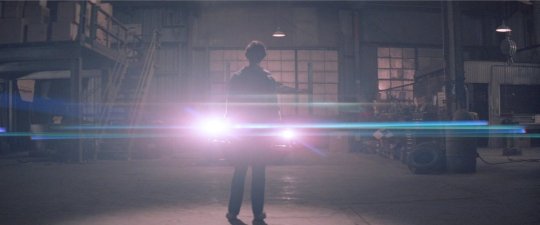
10. Christine (1983)
On paper, the combination of a Stephen King story told through the lens of John Carpenter sounds fantastic, and Christine is definitely the type of Stephen King story that can fit the Carpenter bill. Being a teenager can be a frustrating section of life, and for the vast majority, the day that you own a car symbolizes an important step towards maturity and freedom. Stephen King took this ages old scenario and made it a deeper story about finding yourself outside of the protection and orders of others (be it dictator parents, picture perfect friends or a possessed vehicle), and John Carpenter picks up on every nuance of this subtext. Outside of Harry Dean Stanton, the film is cast mostly absent those in the realms of star power (and with all due respect, calling Stanton a traditional star is a stretch)... for my money’s worth, I imagine that Carpenter did this consciously in order to let Christine be the star of her story. Halloween proved that Carpenter knew a thing or two about horror films, and Christine shows that he can apply that formula with such precision that an inanimate object becomes terrifying.


9. Starman (1984)
Starman is one of those movies that I’ve always been familiar with, but never took the time to seek out and watch… so much so that I didn’t even realize that it was a John Carpenter film until I started working on this list. Tonally, the film differs from other John Carpenter offerings, as it has more Spielberg energy to it than it does Carpenter stylings (although it does embrace the use of practical special effects, albeit outside of a battle or shock-based context). The invasiveness of an alien lifeform morphing into your lost love one right before your eyes is certainly jarring, but it makes for a stellar hook that yanks the viewer right into the heart of the narrative matter. By using Jeff Daniels’ Starman as a surrogate for someone with no understanding of human customs, Carpenter is able to extoll core human values without coming off as holier than thou or preachy, all the while setting up a buddy road trip scenario in order to accelerate the interaction between his leads and capture some countryside photography along the way. For a director known for doing the most, Starman is a surprisingly tender venture, succeeding via the use of less from a director associated with always doing more.


8. Village of the Damned (1995)
The best thing about Village of the Damned is how much it feels like John Carpenter hitting the randomizer button and striking gold with every bit of output. Do you dig small creepy towns? How about unexplained weather anomalies? Strange occurrences and phenomena? A cult made up of psychic kids with mind control abilities that woke up and chose violence? Maybe even a little conspiracy and paranoia? This film has all of that and then some. The film actually stands out as one of the best looking in the Carpenter canon, with a surprisingly vivid use of color implemented that offsets the shades of grey the children are bathed in. Everything about this movie is drenched in a heavy creep factor, especially the performances of the children, who manage to be so pitch perfect in their characterizations that it is genuinely unsettling. Watching this story unfold is one of the most enjoyable experiences presented by Carpenter, and it stands as an example of when a fascinating concept is met with brilliant execution.


7. Memoirs of an Invisible Man (1992)
Memoirs of an Invisible Man came out at an interesting crossroads between my budding interest in film, the idling of John Carpenter’s career, and the downward spiral that was Chevy Chase’s career. Looking at it through an objective lens is rough, but time (and the task at hand) has allowed me to do so, and I find that I still enjoy this film as much now as I did then. The special effects at the time were downright jaw-dropping, and many of them still hold up. The practical effects help sell the illusion, so much so that the illusion is implied in points that it would be a budgetary burden and still manages to not distract. With Chase in the lead, one would imagine that the film would be funny, and while not a comedy, it does allow for several beats of well-timed comedic moments. At the time, the film’s narrative was panned for being uninspired, but in my opinion, some of the harsh judgement may have come from the expectations set by the careers of Carpenter and Chase. While not your standard John Carpenter affair, the film does showcase his ability to “play the game” and create solid work, even if it continues to be harshly judged and misunderstood.

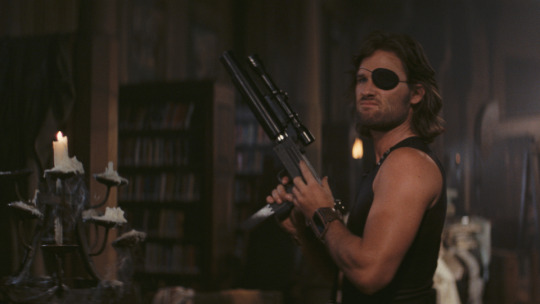
6. Escape from New York (1981)
When it comes to actors connected to directors, it’s usually not long before the pairing of Kurt Russell and John Carpenter comes up, and Escape from New York marks the genesis of this cinematic bond. With his traditional good looks, no-nonsense attitude and penchant for sharp wit, Russell was the perfect leading man for Carpenter’s vivid cinematic exploitation ventures. As for Escape from New York, the city had yet to undertake its Disneyfication of the 1990s, and the movie stands as a bleak vision of what the crime and moral dissonance of the city (and era) could lead to if taken to the extreme. Creating the worst place in America as an inescapable pit to drop the President into immediately sets the stakes high, and with little to no background, we are given the one man seemingly capable of achieving against impossible odds in the form of Snake Pliskin. Like some kind of urban Mad Max, Escape from New York gets wilder and wilder as the minutes tick away, making it one of the most iconic New York films to date, and one of the strongest offerings from John Carpenter during his legendary run.


5. Halloween (1978)
The first of many John Carpenter classic films, and arguably the most iconic of the bunch. Three films in, John Carpenter not only managed to turn one of the biggest profits in independent film history, but he created one of the all time great movie monsters in Michael Myers. The film put Jamie Lee Curtis on a rocket to success, turning her from a burgeoning television hopeful to a certified rising Hollywood star in just one role. In terms of pure production, the trend of growth continued for Carpenter as his cinematography gained more freedom of expression, the performances from his actors and actresses felt more natural, and quite possibly most importantly, his scoring ability was hitting maximum resonance, with the main theme of Halloween being equally as iconic as Michael Myers himself. The film has become an October staple for the masses, but manages to be enjoyable any time of the year due to its sheer ability to entertain and frighten audiences. If one were looking for a singular example of the John Carpenter aesthetic, Halloween stands out as a smart choice. Bonus points to John Carpenter for giving the Howard Hawks produced version of The Thing a shoutout two whole films before remaking it.


4. In the Mouth of Madness (1994)
Films about collective psychosis are nothing new… be they fodder for popcorn consumption such as Fallen or Identity, or teetering on the realms of art like Jacob’s Ladder, they are always a strong foundation for something memorable. Maybe that’s why In the Mouth of Madness seems at once exciting and familiar while watching it, as collective psychosis provides John Carpenter with plenty of ingredients to make his trademark-worthy best. Building an entire referential lore around fictional fiction writer Sutter Cane builds all kinds of abstract immersion layers to explore, especially with direct references (and delightful digs) at Stephen King and his Multiverse. Sam Neill and Julie Carmen take us by the hand and yank us through the innovative twists and turns with wonderful chemistry, with Neill giving an especially cavalier performance. The film has a billion and a half production touches that put the creep factors on overdrive, with some of the directing choices nearing the realms of Lynchian. It’s also a nice touch to hear Carpenter back in the scoring chair (even in a shared capacity). Films like this one aren’t done justice via rumination, review or commentary… it’s best to just dive in and deal with the repercussions on the other side of it all.

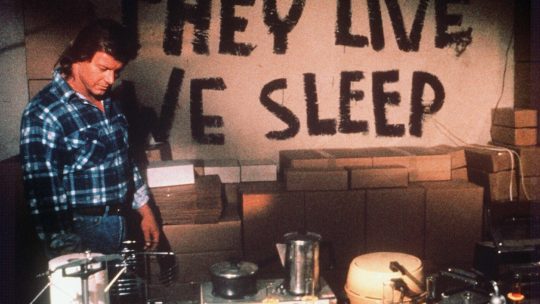
3. They Live (1988)
John Carpenter has made some amazing films in his time, but there are a small chosen few that contain genius-level writing and execution. Of this upper class of films, it’s arguable that They Live is both the most entertaining and the most thought provoking in terms of what it is saying (not to mention how much more relevant that message has gotten over time). A damning examination of capitalism, mass consumption, class divides, media influence and the use of police state tactics, Carpenter paints his science fiction with bold strokes of relevant facts that many often choose to ignore. The action in the film is top notch (including quite possibly one of the best fight scenes ever captured on film between Roddy Piper and Keith David), the makeup work on the aliens is instantly iconic, and the story not only sticks with you, but contains aesthetic elements reminiscent of Jenny Holzer’s influential artwork while being used for an identical purpose. If this list centered solely on John Carpenter minor box office successes that became top tier cult classics, They Live would likely occupy the top spot.


2. The Thing (1982)
The Thing is one of those movies that works on so many levels that it’s hard to fathom. The shorthand used to set up the story gives you a clear understanding of the situation with minimal use of exposition that is replaced by loads of character and world building. The threat is initially unclear, but the indication of its eventual impact kicks off the film with context that is only understood after your first complete viewing. John Carpenter turned over the scoring helm to Ennio Morricone, perhaps the only individual who could score a Carpenter film better than Carpenter himself, and the results are classic. The special effects work is brilliant, as it is not only initially shocking to see the terrifying transformations the creature undertakes, but it is deeply traumatic in a way that sticks with viewers permanently. Carpenter could not have asked for a better ensemble cast, especially considering that it seems like everyone came prepared to play team ball rather than try and outshine one another. It’s always fascinating to me that this film was widely rejected both critically and at the box office upon release, as it took me way too long to get around to this one (and I was only 3 at the time of release). I’ve always encountered nothing but deep fandom for the film, and rightly so, as this film is a masterpiece that deserves every piece of praise it receives.

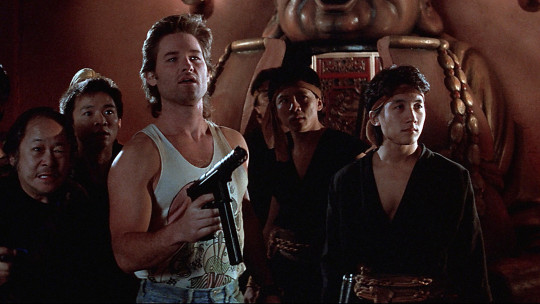
1. Big Trouble in Little China (1986)
What doesn’t this film do right? Kurt Russell is giving his all as Jack Burton, and the film beautifully wraps itself around him in a hurricane of action-based slippery slopes. Setting the film in San Francisco automatically gives it a memorable aesthetic, and locking down the majority of the film in iconic Chinatown is nothing but cinematic gold. We’re told that we’re going to get an unbelievable story, then we meet our everyman that will guide us along on our journey, but very quickly his expectations (and by extension, ours) are blown clear out of the water, and things continue to escalate at an exponential rate. Memorable runs in high quantity and quality for this venture… some of the most quotable John Carpenter film lines come from Big Trouble in Little China, his score for the film ranks high among the canon, the special effects are electrifying (pun intended), the action is high octane, and the martial arts is treated with complete respect in its presentation. Outside of They Live or Vampires, this is arguably the most fun film of the Carpenter collection, and is almost guaranteed to turn the unfamiliar into fans.
#ChiefDoomsday#DOOMonFILM#JohnCarpenter#DarkStar#AssaultOnPrecint13#Halloween#TheFog#EscapeFromNewYork#TheThing#Christine#Starman#BigTroubleInLittleChina#PrinceOfDarkness#TheyLive#MemoirsOfAnInvisibleMan#InTheMouthOfMadness#VillageOfTheDamned#EscapeFromLA#Vampires#GhostsOfMars#TheWard
0 notes
Photo

New Post has been published on https://magzoso.com/tech/frozen-2-review-disney-sequel-has-sparks-of-magic-but-is-it-better-than-the-original/
Frozen 2 Review: Disney Sequel Has Sparks of Magic, but Is It Better Than the Original?

Early into Frozen 2 — the sequel to the 2013 hit Disney animated musical film — one of the two leads in Elsa (Idina Menzel) sings: “I’ve had my adventure, I don’t need something new. I’m afraid of what I’m risking if I follow you.” Those lyrics are part of “Into the Unknown”, a solo with a wordless appearance for the Norwegian singer Aurora that comes closest to the earworm success of “Let It Go”, but they can also be read as a reference to the film’s existence in the first place. Outside of the fact that the original made over a billion dollars and became the biggest animated movie of all time upon its release, why did Disney make Frozen 2? And does it have a bigger purpose than to simply refuel Disney’s merchandising efforts?
The short, easy answer: not really. The original Frozen took on fairy-tale conventions — among them, a gullible Anna (Kristen Bell) as she quickly fell in love with Hans, who turned out to be not “Prince Charming” but the villain — and gave them a modern spin. What made it even more interesting was that Disney itself has been responsible for most of those fairy-tales. It almost felt like the studio was having a laugh at its own expense. Almost. And others construed “Let It Go” to have pro-LGBT undertones, which led fans to speculate if Elsa would be Disney’s first lesbian princess. But Frozen 2 neither re-defies fairy tales nor goes further with Elsa’s unexplored sexuality. It plays it safe.
That doesn’t mean Frozen 2 — from returning directors Chris Buck and Jennifer Lee, working off a script by Lee — has nothing to say. But its new themes, which have to do with environmentalism, indigenous people, historical wrongs, and supportive male partners, though important on their own, aren’t delivered with the same conviction and style of the 2013 original. Its messaging lacks the emotional resonance that was at the heart of Frozen, and ultimately, feels half-baked. And in being more mature, Frozen 2 is aimed at the kids who grew up with the first one, which means parents will likely need to do more explaining to the younger ones, as seemed to be the case at the India premiere.
Frozen 2 begins with a flashback to Elsa and Anna’s childhood, where their parents — King Agnarr (Alfred Molina) and Queen Iduna (Evan Rachel Wood) — essentially set up the building blocks of the sequel, involving an enchanted forest that was enveloped in an impenetrable fog after the four forest spirits were enraged for reasons not entirely clear. Thirty-four years later and a little over three years since the events of the original film, everything is fine and dandy in the kingdom of Arendelle. As further proof, the cast croons how “Some Things Never Change”. Except Elsa is being pulled to a mysterious voice only she can hear, which is all the more alluring given the title of Queen has never really been her true desire.
In her attempts to reach out via song — this is where “Into the Unknown” comes in — Elsa accidentally awakens the enchanted forest spirits, which in turn take out their anger on Arendelle, putting her people out of a home. Now, Elsa has no option but to journey north towards said forest. Anna protests because she’s concerned for her sister, but she — and her boyfriend Kristoff (Jonathan Groff), his reindeer Sven, and the talking snowman Olaf (Josh Gad) — eventually tag along. It’s here that Frozen 2 properly kicks into gear, with the makers getting the opportunity to showcase new locales and magical elements, as they make use of autumn’s range of colours, Nordic folklore, and salamanders to bring it to life.
Narratively, Frozen 2 is fairly predictable, either because it hints too strongly or because its twists aren’t original at all. And in filling in gaps and addressing held-over queries, it ends up revisiting what it sort of tackled already in the first film: family bonds. It doesn’t know how to add to what has come before, and hence it can’t provide the character growth that a sequel demands. The more interesting family thread is the one that deals with the sins of the past. Its message is progressive as it should be, but the need to have a happy ending gets in the way. Other characters suffer too. Kristoff has no role in the plot, so he’s ruled out of Frozen 2 midway, and Olaf’s concerns about growing up are never brought home.

Anna and Olaf in Frozen 2
Photo Credit: Disney
For what it’s worth, those two — Olaf and Kristoff — are responsible for some of the biggest laughs in Frozen 2. (At the India premiere, the younger ones hollered the most at Olaf’s inquisitiveness and obliviousness, and Elsa’s showcase of her near-limitless powers.) Though most of Olaf’s comedic lines will likely be too on-the-nose for adults, a standout moment for Gad is his breathless recap of the events of the original. Speaking of self-aware humour, Elsa admits she too can’t stand “Let It Go”, the closest Frozen 2 comes to a fourth wall-breaking moment. With Kristoff, the highlight is “Lost in the Woods”, a power ballad that channels ‘80s glam rock and is replete with every music video cliché you can dream of. It’s deliberately cheesy and campy, and it’s a hoot.
But those delightful scenes aren’t enough to lift up a sequel that simply isn’t as inspired as the original in both forms of writing: the story or the songs. (Wife-husband duo Kristen Anderson-Lopez and Robert Lopez return as the songwriters, and they also played a part on the former too this time around.) Sure, Frozen 2 had bigger boots to fill since no one at Disney expected Frozen to become the hit that it did. But director Buck and writer-director Lee are unable to spin a new yarn that has the same staying power as Olaf in permafrost. In the end, it ends up being a film that has lots to show but little to say, a common critique for films today that are trying to cash in.
Of course, if Frozen 2 ends up making a billion dollars as well on the back of the original’s success, Disney will no doubt want a third entry somewhere down the line. But — to paraphrase Elsa — I’ve had my adventure and I’m afraid of what Disney risks if it follows the money.
Frozen 2 is out November 22 in cinemas in India in English, Hindi, Tamil, and Telugu.
1 note
·
View note